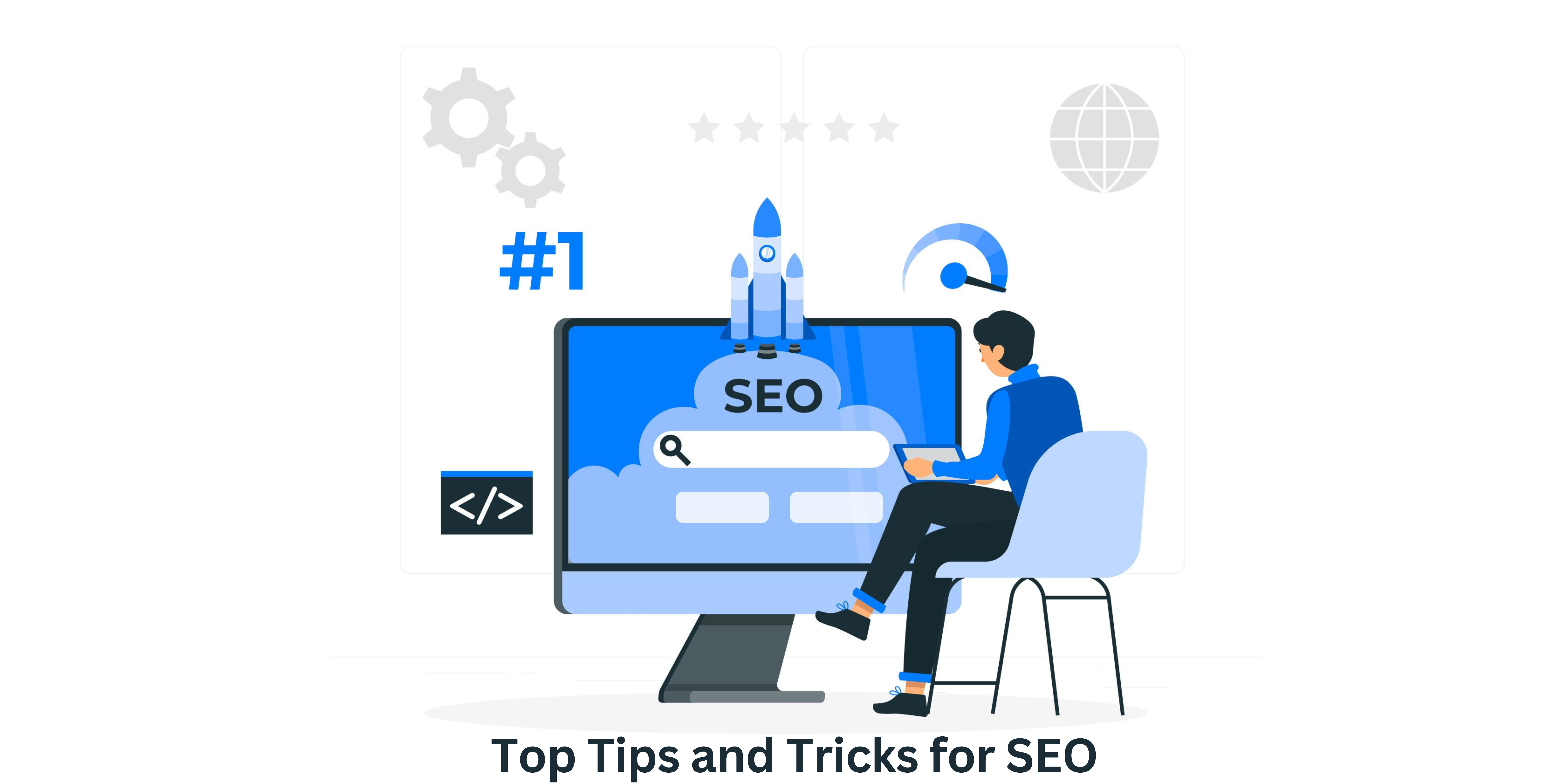Introduction
In today’s digital era, having a strong online presence is crucial for businesses of all sizes. The search engine landscape is constantly evolving, making it essential for companies to optimize their websites and stay ahead of the competition. Search Engine Optimization (SEO) plays a vital role in ensuring that your website is visible to potential customers when they search for relevant keywords on search engines like Google. In this article, we will delve into the top 10 tips and tricks for effective SEO implementation.

What is SEO?
SEO refers to a set of strategies and techniques aimed at improving a website’s visibility on search engine result pages (SERPs). It involves optimizing various elements on a website, both on-page and off-page, to enhance its relevancy and authority in the eyes of search engines. By implementing effective SEO tactics, businesses can attract organic traffic, increase conversions, and boost their online visibility, ultimately leading to greater brand exposure and revenue generation.
Importance of SEO for Businesses
In today’s hyper-competitive market, simply having a website is not enough. With millions of websites vying for users’ attention, businesses need to invest in SEO to stand out from the crowd. Here are the key reasons why SEO is crucial for businesses:
- Increased Organic Traffic: SEO helps businesses attain higher visibility on search engines, leading to increased organic traffic. By appearing on the first page of search results, businesses can reach their target audience and potentially gain more customers.
- Cost-Effective Marketing: Compared to traditional marketing methods, SEO offers a cost-effective approach. Investing in SEO can provide long-term benefits, resulting in sustained organic traffic without the need for continuous advertising expenditure.
- Builds Credibility and Trust: Websites that appear higher in search results are perceived as more credible and trustworthy by users. Properly optimized websites have higher chances of attracting potential customers and establishing a positive online reputation.
- Competitive Advantage: Implementing effective SEO strategies gives businesses a competitive edge. By outranking competitors in search results, businesses can capture a larger market share, improve brand recognition, and position themselves as industry leaders.
- Enhanced User Experience: SEO is not just about optimizing for search engines; it also focuses on creating a seamless user experience. Websites that prioritize user-friendly navigation, engaging content, and fast loading speeds are more likely to convert visitors into valuable customers.
On-Page SEO Optimization
Keyword Research and Analysis
- Choosing Relevant Keywords
- Thorough keyword research is essential for identifying the most relevant and high-performing keywords for a website. This involves understanding user intent, analyzing keyword competition, and identifying long-tail keywords.

- Long-tail keywords are longer, specific phrases that target a niche audience. They often have lower competition and higher conversion rates.
Content Optimization
1. Creating High-Quality Content
- High-quality content is the backbone of successful SEO. It should be engaging, informative, and unique to provide value to users.
- Content should incorporate relevant keywords naturally, without compromising readability or user experience.
2. Optimizing Title Tags and Meta Descriptions
Title tags and meta descriptions are HTML elements that help search engines understand the content of a webpage. Optimizing them with relevant keywords and compelling descriptions can improve click-through rates.
3. Utilizing Header Tags
- Header tags (H1-H6) provide a hierarchical structure to the content, making it easier for search engines and users to navigate and understand the webpage’s main topics. Properly using header tags can enhance the readability and SEO-friendliness of the content.
URL Structure and Site Navigation
1. Creating SEO-friendly URLs
- SEO-friendly URLs should be concise, descriptive, and contain relevant keywords. They should also be easy to read and understand by both search engines and users.
2. Improving Site Navigation
- User-friendly website navigation ensures that visitors can easily navigate through the site and find the desired information. Clear navigation menus, intuitive menus, and breadcrumbs can enhance the user experience and aid search engine crawling.
Internal Linking
1. Linking Strategies
- Internal linking connects different pages within a website, providing visitors with more relevant content and helping search engines discover and understand website hierarchy. Implementing a comprehensive internal linking strategy can boost SEO performance.

2. Anchor Text Optimization
- Optimizing anchor text involves using descriptive and relevant keywords as clickable links. This helps search engines understand the context and relevance of the linked pages, contributing to better search rankings.
Off-Page SEO Techniques
Backlink Building
1. Obtaining High-Quality Backlinks
- Backlinks from reputable and authoritative websites are valuable for SEO. Building relationships, creating valuable content, and leveraging social media platforms are effective ways to obtain high-quality backlinks.
2. Guest Blogging and Outreach
- Guest blogging involves creating content for external websites in exchange for a backlink. Outreach efforts help strengthen relationships with other website owners, leading to more opportunities for guest blogging and quality backlink acquisition.
Social Media and Branding
1. Leveraging Social Media Platforms
- Active presence on social media platforms can boost a website’s visibility, attract followers, and generate engagement. Sharing valuable content, responding to user inquiries, and fostering relationships can contribute to improved SEO results.

2. Building a Strong Brand Presence
- Strong branding establishes trust and credibility, making it easier to attract backlinks and engage users. Consistent branding across various channels, including websites, social media, and offline marketing, can enhance SEO performance.
Online Directories and Local SEO
1. Submitting to Local Directories
- Submitting business information to local directories, such as Google My Business, Yelp, and Yellow Pages, can improve local visibility and increase the chances of appearing in local search results.
2. Optimizing Google My Business Listing
- Optimizing a Google My Business listing includes providing accurate and updated information, verifying the business location, adding relevant photos, and encouraging customer reviews. This helps in improving local search rankings and attracting potential customers.
Technical SEO Optimization A. Mobile Optimization
Responsive Design and Mobile-Friendly Pages
- Mobile optimization ensures that websites are accessible and visually appealing on various mobile devices. Responsive design and mobile-friendly pages contribute to better user experience and improved rankings in mobile search results.
Website Speed and Performance

Optimizing Image Sizes
- Optimizing images by resizing, compressing, and using appropriate file formats can significantly improve website loading speed. Fast-loading websites provide a better user experience and are favored by search engines.
Structured Data Markup
Implementing Schema Markup
- Schema markup helps search engines understand the content and context of a webpage better. It provides additional information in search results, such as star ratings, event dates, and product prices, making the website more enticing to users.
User Experience and Engagement A. Mobile User Experience
Responsive Design
- Responsive design ensures that websites automatically adapt to different screen sizes, providing a consistent and user-friendly experience across devices. Seamless mobile user experience contributes to better engagement and higher search rankings.
Quality and Relevant Content
Engaging and Informative Articles
- Quality content that engages readers and offers valuable information establishes credibility and attracts natural backlinks. Content should be well-researched, properly structured, and visually appealing to keep users on the website longer.
Website Security and SSL Certificate
The Importance of SSL
- Implementing an SSL certificate ensures secure communication between the website and its users by encrypting data. Apart from protecting user information, SSL certificates also contribute to better search rankings, as search engines prioritize secure websites.
Measuring SEO Success A. Analyzing Website Metrics
Tracking Organic Traffic
- Monitoring organic traffic through tools like Google Analytics helps measure the effectiveness of SEO strategies. Tracking changes in organic traffic over time allows businesses to assess the impact of optimization efforts.
Utilizing SEO Tools
Google Analytics
- Google Analytics provides comprehensive data about website traffic, user behavior, and conversion rates. Utilizing its features, such as goal tracking and behavior flow analysis, helps identify SEO opportunities and optimize website performance.

SEO Keyword Tracking Tools
- Keyword tracking tools, such as SEMrush and Moz, allow businesses to monitor keyword rankings, analyze search volumes, and track competitors. These tools assist in optimizing keyword strategies and identifying new opportunities.
By following these tips and tricks, you can improve your website’s SEO and increase its visibility on search engines. It’s important to keep in mind that SEO is an ongoing process, so it’s important to regularly review and optimize your website to ensure it is performing well.
Frequently Asked Questions
SEO results can vary depending on factors such as the competitiveness of keywords, website authority, and the level of optimization. Generally, businesses can start seeing improvements in organic rankings and traffic within a few months. However, long-term SEO efforts are required for sustained success.
While it is possible to handle SEO in-house, hiring an experienced SEO agency can provide substantial benefits. SEO agencies possess expertise in the field, stay up-to-date with the latest industry trends, and can formulate tailored strategies based on a business’s unique requirements.
Common SEO mistakes to avoid include keyword stuffing, using irrelevant or low-quality backlinks, neglecting mobile optimization, and not creating engaging content. It is crucial to comply with search engine guidelines, stay updated with algorithm changes, and regularly analyze and adapt SEO strategies.
SEO plays a significant role in boosting the visibility of local businesses. Local SEO techniques, such as optimizing Google My Business listings, submitting to local directories, and targeting location-specific keywords, help improve rankings in local search results. This increases the chances of attracting local customers and driving foot traffic to physical stores.
Yes, SEO tactics can vary for different industries due to variations in target audiences, keyword competitiveness, and industry-specific search trends. It is important to conduct thorough research and employ strategies that align with the unique characteristics of the industry.
Conclusion
Implementing effective SEO strategies is essential for businesses seeking online success. By focusing on on-page and off-page optimization techniques, technical SEO aspects, user experience, and measuring SEO success, businesses can improve their website visibility, attract organic traffic, and ultimately achieve their marketing goals. Whether businesses decide to handle SEO in-house or seek professional assistance, understanding and implementing the top 10 SEO tips and tricks discussed in this article will undoubtedly pave the way for online success.
